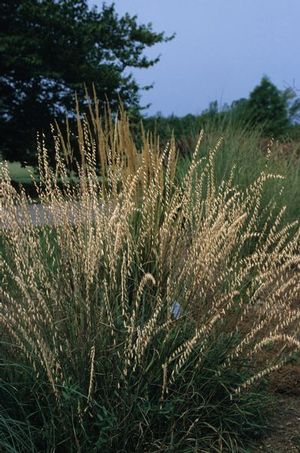New Moon Nurseries

A warm season grass, sideoats grama is extremely drought tolerant and useful for erosion control and soil stabilization.
Bouteloua curtipendula
Sideoats grama
Native to North America
FIRST IMPRESSIONS: Bouteloua curtipendula is a petite clump forming perennial grass. In late spring arching culms rise above the wiry bluish-green leaves.
The culms are adorned with dangling purple tinted spikes and orange stamens. The unique spikes and tan oat-like seed that follow hang from only one side of the stalk. This is a tough drought tolerant grass that can survive in harsh dry prairies where grazing occurs or can prosper in sunny gardens with dry to average soils.
HABITAT & HARDINESS: Bouteloua curtipendula occurs in the lower Canadian provinces and in the United States in all but 6 of the lower 48 states. This grass is most common in the Midwestern prairies and is widespread but less frequent outside of the Great Plains.
Plants are indigenous to glades, prairies, open rocky woodlands, wooded bluffs, barrens and railroad right-of-ways.
This grass is hardy from USDA Zones 3-9.
PLANT DESCRIPTION: Bouteloua curtipendula is an unbranched warm season perennial grass less than 3’ tall. Plants hold soil with their vigorous fibrous roots and expand slowly from scaly underground rhizomes.
This grass has blue-green linear leaves with distinct stiff hairs along the margins. The erect foliage is mostly basal and less than 20” long. A few smaller leaves are scattered on the culms above.
By mid-summer, culms sport unique flower clusters that are described botanically as “spike-like panicles”. The panicles are arranged on arching stems 1-2’ above the leaves. Between 25 and 50 greenish, reddish or purplish floral spikes dangle on one side of the culm.
As the flowers transition into seed they morph into light tan pendant oat-like clusters.
The display is striking when the foliage colors in fall. The leaves generally turn golden brown with earthy orange and red highlights.
Plants attain 1-3’ height with 2’ spread.
CULTURAL & MAINTENANCE NEEDS: Bouteloua curtipendula prospers in full sun and dry or average alkaline soil. Plants do not tolerate shading by taller plants.
After establishment this grass tolerates controlled burns and thrives even when exposed to drought or grazing.
Plants are happy in clay, sandy or gravelly soils, on slopes and in extreme drought.
This grass needs little maintenance except to be cut or burned to the ground in late winter.
LANDSCAPE USES: Useful as an Accent, Groundcover or for Erosion Control. Bouteloua curtipendula is often used as part of a Grouping or Mass Planting. It provides Fall Color and Winter Interest. Plants are appropriate for Water-wise Landscapes, Low Maintenance Plantings, Meadow or Prairie Gardens, Perennial Borders, Roadsides and Restoration Projects.
COMPANION & UNDERSTUDY PLANTS: Try pairing with Asclepias tuberosa, Echinacea purpurea, Rudbeckia fulgida var. fulgida, and Schizachrium scoparium.
Schizachyrium scoparium is similar in appearance and cultural needs and can be substituted if needed.
TRIVIA: Bouteloua curtipendula is larval host to green and dotted skippers. Wild turkeys and upland birds feed on the seed. This is a nutritious forage grass that livestock readily graze.
This low sod forming grass was selected at the state grass of Texas.
The Latin word curtipendula means "hanging down somewhat" and probably refers to the pendant flowers and fruit.
Phytoremediation: PAH's
Height:
1-3 ftSpread:
2 ftSpacing:
3-4 ftUSDA Hardiness Zone:
3-9Bloom Color:
Green, TanBouteloua curtipendula Characteristics
Attracts Wildlife
- Songbirds
Attributes
- Ground Cover
- Drought Tolerant
- Dried Flower
- Cut Flower
Exposure
- Full Sun
Deer Resistant
- Deer Resistant
Flowering Months
- July
Grass Season
- Warm Season Grass
Juglans nigra Tolerance (Black Walnut)
- Yes
Salt Tolerance
- Medium
Soil Moisture Preference
- Dry
Interesting Notes:
For more information on this plant, visit the USDA PLANTS Database: http://plants.usda.gov/java/profile?symbol=BOCU